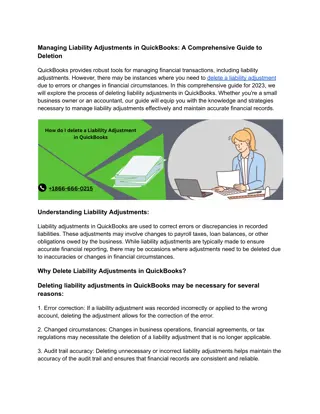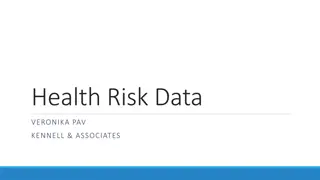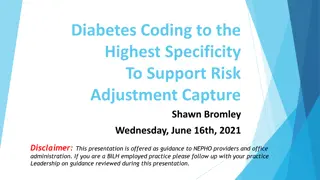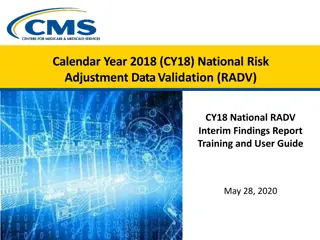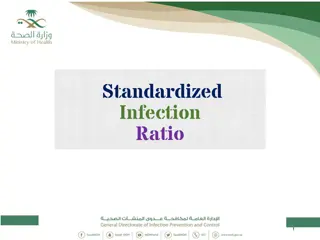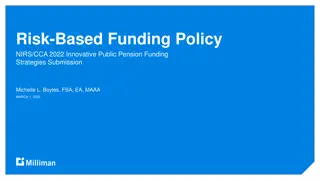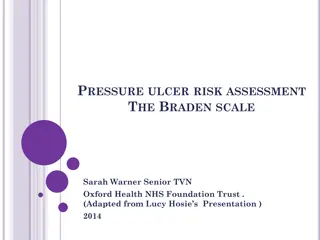Understanding Risk Adjustment and HCCs in Healthcare
Risk Adjustment and Hierarchical Condition Categories (HCCs) play a crucial role in predicting healthcare expenditures and reimbursement. HCCs are utilized in both government and private insurance plans to assess the health status of patients and allocate resources accordingly. Factors such as age, gender, and specific diagnosis codes impact risk scores, which in turn affect reimbursement amounts. This system is complex but vital for ensuring accurate and fair financial support in healthcare services.
Download Presentation

Please find below an Image/Link to download the presentation.
The content on the website is provided AS IS for your information and personal use only. It may not be sold, licensed, or shared on other websites without obtaining consent from the author. Download presentation by click this link. If you encounter any issues during the download, it is possible that the publisher has removed the file from their server.
E N D
Presentation Transcript
Association of Clinical Documentation Improvement Specialists Indiana Chapter Indianapolis, IN April 21, 2018
What are HCCs? Risk adjustment system based on diagnosis codes HHS-HCCs ACA plans Adult model (Ages 21 and up) Child Model (Ages 2 20) Infant Model (Ages 0-1) Predict current year expenditures CMS-HCCs Medicare Advantage Predict next year s spending Danita Forgey Consulting, LLC
HHS HCCs 83 CMS HCCs and < 200 HHS HCCs Demographics built into HCCs Each metal level weighted differently Platinum, gold, silver, bronze, catastrophic Banding Some HCCs restricted to particular criteria Infant risk score based on maturity category at birth and highest level of severity Danita Forgey Consulting, LLC
HCC Hierarchies Age and gender also impact risk score If multiple codes group to the same hierarchy, only the highest weighted HCC impacts risk score If group is listed in this column.. drop the disease group(s) listed in this column HCC 8 Metastatic Cancer and Acute Leukemia 9,10,11,12 9 Lung and Other Severe Cancers 10,11,12 Danita Forgey Consulting, LLC
Interaction Type High cost and medium cost Only one interaction per patient High cost supersedes medium cost Risk score determined by interaction factor and severe illness indicator SI indicators include HCCs for sepsis, peritonitis, seizure disorders Only qualifies as an interaction with specific HCCs Danita Forgey Consulting, LLC
Example of Risk Scores ICD-10 Codes HCC Group Demographic Factor Total Community Factor Female 65-69 years 0.312 E10.9, type I diabetes without complication 19 Diabetes without complication 0.104 I5021 Acute systolic (congestive) heart failure 85 Congestive heart failure 0.377 Interaction Diabetes/CHF 0.287 Total Risk Factor 1.08 Danita Forgey Consulting, LLC
How Risk Score Affects Reimbursement Base payment $9,000 Risk adjustment factor 1.08 $9000 X 1.08 = $9,720 Risk score also affected by health plan Danita Forgey Consulting, LLC
Diagnosis Codes Conditions must be documented in the medical record Must be a face-to-face visit Acceptable data sources Hospital inpatient facilities Hospital outpatient facilities Physician offices Submitted at least once during the risk adjustment data-reporting period Danita Forgey Consulting, LLC
Diagnosis Codes Diagnosis codes are not used from the following providers SNF Hospital inpatient swing beds Intermediate care facilities Respite care Hospice Ambulatory surgery centers Home health Free-standing dialysis facilities Danita Forgey Consulting, LLC
Diagnosis Codes Only submitted according to official coding and reporting guidelines Outpatient coding guidelines to keep in mind Cannot report unconfirmed conditions Codes reported for chronic conditions as many times as the patient receives treatment and care for the condition Codes assigned for all conditions that coexist at the time of the encounter and require or affect patient care or treatment SYMPTOM CODES AND UNSPECIFIED CODES TYPICALLY EXCLUDED Danita Forgey Consulting, LLC
Diagnosis Codes Follow-Up Document specific condition being followed Medical Necessity Plans that require prior approval may require specific diagnosis documentation or results of prior diagnostic testing for payment for approval process History codes Code only if impacts current care or treatment Danita Forgey Consulting, LLC
Diagnosis Codes Inpatient guidelines for assigning codes for additional conditions Clinical evaluation Therapeutic treatment Diagnostic procedures Extended length of hospital stay Increased nursing care and/or monitoring Danita Forgey Consulting, LLC
Diabetes HCC 17 Diabetes with Acute Complications HCC18 Diabetes with Chronic Complications HCC19 Diabetes without Complication Link between chronic conditions and diabetes Danita Forgey Consulting, LLC
Cardiovascular Conditions Documentation of tobacco use or exposure Hypertension and related conditions Chronic kidney disease Heart failure and other cardiovascular conditions Specific types of heart failure Danita Forgey Consulting, LLC
Ulcers and Wounds Ulcers are associated with HCCs Wounds are traumatic or surgical and not associated with HCCs Underlying cause of ulcer Danita Forgey Consulting, LLC
Chronic Kidney Disease Dialysis status Acute vs chronic Stage Hypertension Danita Forgey Consulting, LLC
Documentation Requirements Active treatment of the condition must be reported at least annually. Documentation must indicate whether a condition is currently under treatment or surveillance Plan that specifies treatment for each condition listed Monitored Evaluated Assessed Treated Danita Forgey Consulting, LLC
Documentation Requirements Entries authenticated and dated Legibility Provider credentials Danita Forgey Consulting, LLC
Data Reporting Conditions for CMS HCCs must be reported by June for initial payment Conditions for mid year payments must be submitted by March Conditions for final year payments due in January of the following year Reported at least quarterly Each data submission should represent approximately 25% of the data submitted throughout the year. EDGE server Danita Forgey Consulting, LLC
Data Reporting RAPS Risk Adjustment Processing System FERAS Front End Risk Assessment System Edit system Danita Forgey Consulting, LLC
Optimizing HCCs Review superbills for unspecified codes Review documentation to identify opportunities for greater specificity Review medical necessity denials Timely bill submission Review documentation for legibility and validation Validation of diagnostic findings Danita Forgey Consulting, LLC
Resources Centers for Medicare and Medicaid Services, Risk Adjustment Fact Sheet, April 2015 ICD10 University, The New World of HCCs: What You Need to Know Now ; webinar 1/25/17 Franklin, Janet. "ABCs of HHS-HCCs: Taking a Closer Look at the Commercial Risk Adjustment" Journal of AHIMA 85, no.10 (October 2014): 76-79. 2017 HCCs. April 4, 2016. Available at: https://www.cms.gov/Medicare/Health- Plans/MedicareAdvtgSpecRateStats/Downloads/Anno uncement2017.pdf Danita Forgey Consulting, LLC
Resources CMS; Medicare Managed Care Manual, Chapter 7, Available at https://www.cms.gov/Regulations-and- Guidance/Guidance/Manuals/Downloads/mc86c07.p df CMS, ICD-10-CM Official Guidelines for Coding and Reporting, Fy2017 Franklin, Janet. "ACA Risk Adjustment Models Emerge in Commercial Care" Journal of AHIMA 85, no.9 (September 2014): 68-70. Danita Forgey Consulting, LLC
Resources Security Health Plan; https://www.securityhealth.org/provider- manual/shared-content/claims-processing-policies- and-procedures/risk-adjustment---hcc-coding/ Danita Forgey Consulting, LLC





